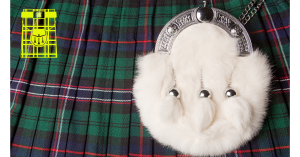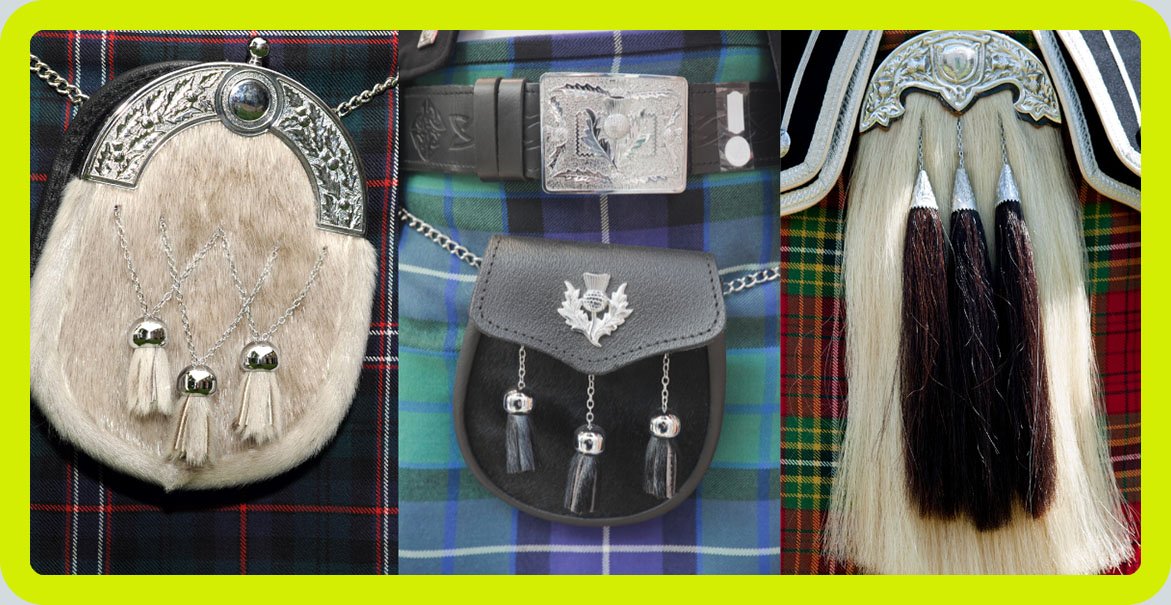The Fascinating History and Types of Sporrans: A Comprehensive Guide
When it comes to traditional Scottish Highland dress, one iconic accessory stands out – the Sporran. This leather pouch, worn with the Kilt, serves a practical purpose while adding a touch of elegance to the attire. In this comprehensive guide, we will delve into the fascinating history and explore the various types of Sporrans available.
The Origins of the Sporran
The Sporran has a long and rich history, dating back to the twelfth century. Highland warriors, described as “bare-legged, with shaggy cloaks and a scrip,” would adorn themselves with this essential accessory. While the rest of Scotland considered such attire as barbaric, the Highlanders embraced their traditional dress, including the sporran.
During this time, Kilts were simple garments, made from Tartan cloth, providing freedom of movement in the rugged Highland terrain. However, the Kilt lacked pockets, necessitating the need for a pouch to carry personal belongings. Thus, the Sporran was born out of necessity, evolving from the medieval purse used by people across Europe.
The Design of a Sporran
Sporrans are crafted with meticulous attention to detail, combining leather, hide, fur, and hair. The typical dimensions of a sporran are approximately 60cm by 40cm, with a stiff leather pouch and a back flap or lid. The lid is often adorned with intricate Celtic designs or embossed patterns, adding a touch of elegance to the accessory.
Most Sporrans feature tassels attached to the front, either directly threaded or connected with decorative chains. In modern sporrans, the interior is lined with soft suede, offering a luxurious feel. Some Sporrans even include additional features such as keyrings and separate pockets for credit cards and coins, catering to the practical needs of the wearer.
Exploring the Types of Sporrans
There are five main types of sporrans, each with its unique characteristics and suitable for different occasions:
1. Day Sporran
The Day Sporran, also known as a casual or leather Sporran, is the most common type worn during the day. Crafted entirely from leather, it traditionally comes in black, although brown, tan, and grey variations are now popular. Day Sporrans are usually plain, with no elaborate adornments, although some may feature Celtic designs or small pewter or chrome studs. This type of sporran hearkens back to the simplicity of the original pouches worn by Highlanders.
2. Dress Sporran
The Dress Sporran is the epitome of formality and is reserved for special events such as weddings. Unlike the Day Sporran, it does not have a flap lid and is designed to open from the top. The front of a dress Sporran is often made from hide, skin, or fur, lending it a luxurious appearance. A decorative cantle, usually made of pewter or silver, adorns the top of the front. The cantle may feature intricate designs and serves as a stud for holding the Sporran open or closed.
3. Semi-dress Sporran
The Semi-dress Sporran strikes a balance between the Day Sporran and the Dress Sporran, making it suitable for both formal events and casual wear. It shares the same construction as the Day Sporran, with a longer back that forms a flap or lid to enclose the pouch. The front of the Semi-dress Sporran is adorned with badges, stud designs, and embossed Celtic engravings. It typically features at least three tassels hanging from decorative chains, adding an elegant touch to the accessory.
4. Animal Skin Sporran
For those seeking a unique and eye-catching Sporran, the animal skin Sporran is an excellent choice. Made from leather and animal fur, this type of sporran showcases the natural beauty of various creatures. The fur is stitched to the front, and the tassels, usually two or three, are also crafted from the same fur. Animal skin sporrans are available in a range of options, including fox, beaver, rabbit, musquash, lamb, coyote, highland cow, and even skunk. Some animal skin Sporrans take it a step further by using the head of the animal as the flap, creating a truly distinctive accessory.
5. Horsehair Sporran
The horsehair Sporran is a striking accessory often worn by pipers in pipe bands and Scottish army regiments. As its name suggests, it is crafted from the hair of a horse’s tail. The front of a horsehair sporran is white, contrasting with the long black tassels, also made from horsehair. Regiments such as the Royal Regiment of Scotland, the Scots Guards, and the Royal Scots Dragoon Guards proudly wear horsehair Sporrans, each with its distinctive design. While the Royal Regiment of Scotland’s sporran features two tassels, both the Scots Guards and the Royal Scots Dragoon Guards sport three.

The Fascinating History of the Sporran
The Sporran’s history can be traced back to its humble beginnings as a simple leather pouch. Originally, it was tied to the belt that held the ‘Feileadh-mhor’, or great Kilt, in place. The Sporran served as a practical purse, enabling Highlanders to carry essential items for the day, such as food, money, and ammunition.
Unlike a knife, which was too long to fit in the sporran, the ‘Sgian Dubh’ (a small knife) was carried in the sock for easy access.
While similar pouches were phased out in other parts of Europe with the advent of pockets, the Sporran remained an integral part of Scottish Highland dress.
The name “Sporran” itself comes from the Scottish Gaelic word “Sporan,” meaning purse or wallet.
Materials Used in Sporran Crafting
Sporrans are crafted using a variety of materials, each lending its unique characteristics to the accessory:
1. Leather
Leather forms the foundation of most Sporrans. It provides durability and a classic look. Some sporrans, such as the day sporran, are entirely made of leather, creating a timeless and versatile accessory. The interior of leather Sporrans is often lined with soft suede, enhancing both the aesthetic appeal and the luxurious feel.
2. Metal
Metal elements, such as pewter, chrome, and silver, are used to create decorative accents on sporrans. These metals are commonly found in the cantle, which adorns the top of dress and regimental Tartan Sporrans. They are also used for the tassel heads and the links in the leather strap that secures the Sporran around the waist. Gold is occasionally used for the most lavish designs, adding a touch of opulence.
3. Animal Skins and Hides
Dress Sporrans often feature front panels made from animal skins and hides, adding a luxurious and unique touch. Traditionally, sealskin was used, but due to a ban on the use of seal products, alternative materials have gained popularity. Hide, skin, fur, and even the heads of animals, such as fox and musquash, are now used to create visually stunning dress sporrans.
4. Horsehair
Horsehair Sporrans, as the name suggests, are made from the hair of a horse’s tail. The hair is collected by grooms at stables during regular grooming sessions. It is carefully checked for any diseases before being sent to Sporran makers. Horsehair sporrans are steeped in tradition and are still worn by Scottish army regiments, reflecting a proud heritage.
How to Wear a Sporran
Wearing a Sporran properly is crucial to maintaining the integrity of the Highland dress.
Here are some guidelines for wearing a sporran with elegance and style:
- The Sporran should be positioned in front of the groin, neither too high nor too low on the Kilt.
- A good rule of thumb is to place the top of the Sporran a hand’s width from the top of the Kilt.
- If you find that the Sporran bounces around too much during activities like dancing, you can adjust the strap holes to secure it more tightly.
- For those wearing a horsehair Sporran, it is traditionally fixed so that the bottom of the Sporran does not extend beyond the hem of the Kilt.
Remember, a Sporran is both a practical and ornamental accessory, designed to be seen and admired. Ensure that it looks and feels right for you, and you’ll be showcasing the true essence of Scottish Highland dress.
Conclusion
The Sporran is an iconic accessory that completes the traditional Scottish Highland dress.
From its humble origins as a simple leather pouch, it has evolved into various types, each with its distinctive characteristics and suitability for different occasions, crafted with care and attention to detail, Sporrans showcase the beauty of materials such as leather, animal skins, and horsehair.
Whether you opt for:
- The classic Day Sporran
- An elegant Dress Sporran
- A versatile Semi-dress Sporran
- An eye-catching animal skin Sporran
- Or a striking horsehair Sporran
Whichever you have or choose, embrace the spirit of the Highlands and wear your Sporran with pride!

